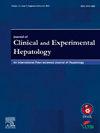碳青霉烯耐药肠杆菌定殖的活体肝移植受者的结果
IF 3.3
Q2 GASTROENTEROLOGY & HEPATOLOGY
Journal of Clinical and Experimental Hepatology
Pub Date : 2025-01-25
DOI:10.1016/j.jceh.2025.102508
引用次数: 0
摘要
背景移植前耐碳青霉烯类肠杆菌(CRE)定植与肝移植(LT)后较差的预后有关。我们旨在分析2019年1月至2022年9月期间成人活体肝移植受者CRE定植的发生率和风险因素及其对肝移植术后预后的影响。直肠拭子用于筛查活体肝移植(LDLT)受者的 CRE 定植情况,并将其分为 CRE 阳性组(CRE-POS)和 CRE 阴性组(CRE-NEG).结果研究共纳入 499 例患者,其中 163 例(32.6%)有 CRE 定植,并接受了预防性益生菌治疗。终末期肝病模型中位数评分(几率比 [OR]:1.05 [95%置信区间{CI}:1.02-1.08])和术前急性肾损伤(AKI)(OR:1.95 [95% CI:1.28-2.98])与术前 CRE 定植独立相关。CRE-POS 患者的术中包装红细胞输血量更高(5 [3, 7] vs 3 [1, 6]),LT 后菌血症(19.6% vs 9.8%,P = 0.004)、胸部感染(25.7% vs 13.6%,P = 0.04)和重症监护室住院时间更长(7 天[四分位数间距{IQR}:5-10] vs 6 天[IQR:5-8] P = 0.006)。两组患者的所有其他围手术期参数(包括存活率)相当。499 例患者中有 65 例出现菌血症,其中 61 例(93.8%)为肠杆菌。术前 CRE 定植(OR:1.9 [95% CI:1.08-3.7])、代谢功能障碍相关性脂肪肝(OR:2.0 [95% CI:1.03-3.89])、术前 AKI(OR:2.4 [95% CI:1.3-4.5])和大量输血(OR:2.0 [95% CI:1.03-3.89])与术后肠杆菌败血症独立相关。CRE菌血症患者的90天死亡率较高(38.4% vs 14.2% P = 0.03)。术后 CRE 菌血症与术前 CRE 定植无关(42.8% CRE-POS vs 57.1% CRE-NEG)。术前 CRE 定植是术后肠杆菌败血症的风险因素,但不是 CRE 菌血症的风险因素。肝移植后 CRE 菌血症的死亡率明显更高。在肝移植前积极监测 CRE,同时使用益生菌等有针对性的先期治疗,以及在发生败血症时根据 CRE 定植情况酌情使用适当的指导性抗生素治疗的低门槛,有助于改善这部分 LDLT 受者的预后。本文章由计算机程序翻译,如有差异,请以英文原文为准。

Outcomes of Living Donor Liver Transplantation in Recipients Colonized With Carbapenem-Resistant Enterobacterales
Background
Pretransplant colonization with carbapenem-resistant Enterobacterales (CRE) is associated with poorer post–liver transplantation (LT) outcomes. We aimed to analyze the incidence and risk factors for CRE colonization in adult living-donor LT recipients from January 2019 to September 2022 and its impact on post-LT outcomes.
Methods
Relevant perioperative parameters including bacteremia within one month post LT were recorded. Rectal swabs were used for screening living-donor liver transplantation (LDLT) recipients for CRE colonization and divided into CRE-positive (CRE-POS) and CRE-negative (CRE-NEG) groups.
Results
A total of 499 patients were included in study, and 163 (32.6%) were CRE colonized and received pre-emptive probiotics. Median Model for End-Stage Liver Disease score (odds ratio [OR]: 1.05 [95% confidence interval {CI}: 1.02–1.08]) and preoperative acute kidney injury (AKI) (OR: 1.95 [95% CI: 1.28–2.98]) were independently associated with preoperative CRE colonization. CRE-POS patients had higher intraoperative packed red blood cell transfusion (5 [3, 7] vs 3 [1, 6]) along with a higher incidence of post-LT bacteremia (19.6% vs 9.8%, P = 0.004), chest infections (25.7% vs 13.6%, P = 0.04), and longer intensive care unit stay (7 days [interquartile range {IQR}: 5–10] vs 6 days [IQR: 5–8] P = 0.006). All other perioperative parameters including survival were comparable between the two groups. Bacteremia developed in 65 of 499 patients of which 61 (93.8%) were Enterobacterales. Preoperative CRE colonization (OR: 1.9 (95% CI: 1.08–3.7]), metabolic dysfunction–associated steatotic liver disease as an etiology of liver disease (OR: 2.0 [95% CI: 1.03–3.89]), preoperative AKI (OR: 2.4 [95% CI: 1.3–4.5]), and massive transfusion (OR: 2.0 (95% CI: 1.03–3.89]) were independently associated with postoperative Enterobacterales septicemia. Patients with bacteremia due to CRE had a higher 90-day mortality (38.4% vs 14.2% P = 0.03). Postoperative CRE bacteremia was not associated with preoperative CRE colonization (42.8% CRE-POS vs 57.1% CRE-NEG).
Conclusion
One-third of patients presenting for LDLT are already colonized with CRE. Preoperative CRE colonization is a risk factor for postoperative Enterobacterales septicemia but not with CRE bacteremia. Post–liver transplant CRE bacteremia has a significantly higher mortality. Active pre-LT surveillance for CRE, along with the use of targeted pre-emptive therapy as probiotics and a low threshold for discretionary use of appropriate guideline-based antibiotic therapy based on CRE colonization status, in the event of sepsis, can help improve outcomes in this cohort of LDLT recipients.
求助全文
通过发布文献求助,成功后即可免费获取论文全文。
去求助
来源期刊

Journal of Clinical and Experimental Hepatology
GASTROENTEROLOGY & HEPATOLOGY-
CiteScore
4.90
自引率
16.70%
发文量
537
审稿时长
64 days
 求助内容:
求助内容: 应助结果提醒方式:
应助结果提醒方式:


